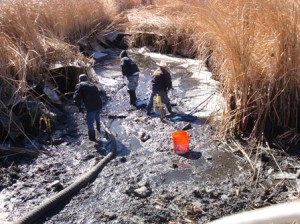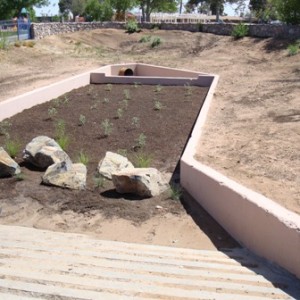 Retrofit of wetlands to arid low impact development (ARID LID)
Retrofit of wetlands to arid low impact development (ARID LID)
The Roskos Field demonstration project was originally established in 2001 to provide a stormwater quality feature that used a wetland to remove street wash toxins prior to the stormwater entering the channel and arroyo.
Over time the wetlands environment required supplemental water as New Mexico dipped into a deeper drought and the system was no longer sustainable solely by stormwater runoff. Additionally, the original vegetation was displaced by invasive species and the wetlands element of the Roskos Field demonstration project ended up being choked out with Cattails. The invasive species increased maintenance costs and created a public nuisance.
n 2013, a decision was made to rehabilitate the area and re-purpose it into an Arid environment Low Impact Development (ARID LID) demonstration garden with water harvesting elements. The new configuration will provide lower maintenance needs and, after the native plant species are established, no supplemental watering will be required. The native plants will also provide phytoremediation of the street toxins in a similar manner to the original wetlands.

The wetlands type vegetation was removed and the facilities were cleaned of all accumulated materials; the first stage of the original wetlands was modified to allow storm flows to infiltrate naturally and the design was modified to increase the capture of the first flush contaminants and sediment. The second stage of the original wetlands was modified to create a dry riverbed system lined with regional native grasses and wildflowers. 
The new system will lower long-term maintenance needs at this location and reduce potential for standing water in structure. Reduction in standing water should greatly reduce mosquito issues and provide the potential for evaporation to eliminate standing water issues.
The ARID LID rehabilitation of Roskos demonstrates the usage of land contour management and selective planting of drought tolerant plants in runoff and landscape management. The topography of the pond was reshaped into swales for runoff water harvesting. Straw bales were added to retain the shape of swales and retain runoff water. The retrofit also incorporated demonstration of traditional water management practices (ollas) for plant irrigation, and replanting of drought tolerant, native vegetation were incorporated into the design. 
The shade structure features two large water harvesting cisterns backing up to landscaped stormwater quality feature. The overall design shaped the bottom of original pond into a dry river-bed configuration incorporating trees. The updated system highlights opportunities for individuals to incorporate ARID LID in their yards along with continuing to provide stormwater treatment on a regional level.

